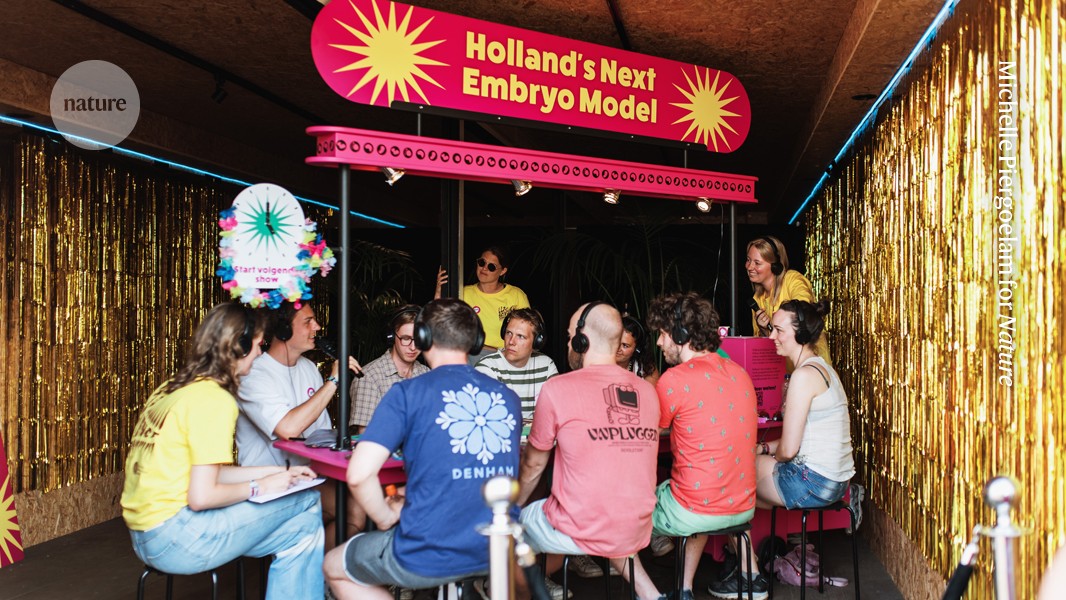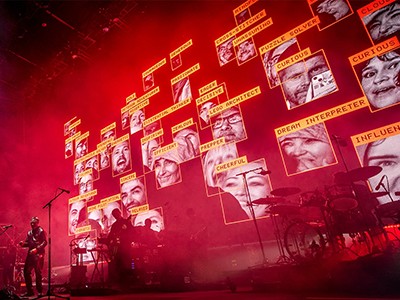As the Sugababes take the stage a few metres away, Eefje Schrauwen stands outside her assigned shipping container. There are other units on either side, each decorated differently. Her container bears a clothes line of women’s underwear — a cheeky nod to the science taking place inside.
Schrauwen, an infectious-disease researcher at Avans University of Applied Sciences in Breda, the Netherlands, is interested in vaginal health. Specifically, she and her team are curious about the microorganism Lactobacillus crispatus, one of the “good bacteria” that has a “happy marriage” with other microbes in the vagina. Schrauwen wants to know what characteristics are important for the bacteria to thrive — and, like any other scientist, needs a way to collect data. She and her colleagues are hoping to convince the thousands of people who will flood the area once the British pop group finishes its set to answer a series of questions — and donate vaginal swabs — for the good of science. They’ve even set up a makeshift laboratory in the back so that festival-goers can get some of their results in real time.
Massive Attack’s science-led drive to lower music’s carbon footprint
It’s not your average science project. But then again, none of the research at Lowlands, a three-day music and performing-arts festival in the Netherlands, is typical. Schrauwen is part of a line-up of researchers conducting experiments as part of Lowlands Science, a decade-long initiative that fosters science engagement at one of the country’s largest festivals.
And it’s not just in the Netherlands that scientists do outreach at festivals. At the NOS Alive music festival near Lisbon, researchers don’t conduct studies on site, but organizers foster engagement with visitors through a science stand and sponsor research scholarships for young graduates. Other music festivals across Europe have integrated science communication into their programmes, realizing the potential of such events.
What is Lowlands?
Since 1993, tens of thousands of people have flocked each year to Biddinghuizen, a village about 70 kilometres northeast of Amsterdam, to camp out for the festival. Although the event already featured scientific lectures and demonstrations, it wasn’t until 2015 that organizers started including actual research studies.
Getting people to participate in research is notoriously difficult and time-consuming, but festivals such as Lowlands introduce a willing audience into the mix. “People at festivals, they’re very willing to experiment or do new stuff,” says Bianca Pander, a managing partner at BKB, a campaign firm in Amsterdam that organizes Lowlands Science. “Maybe in the evenings, they want to go to bands, but during the day, they have time to do other stuff as well.”
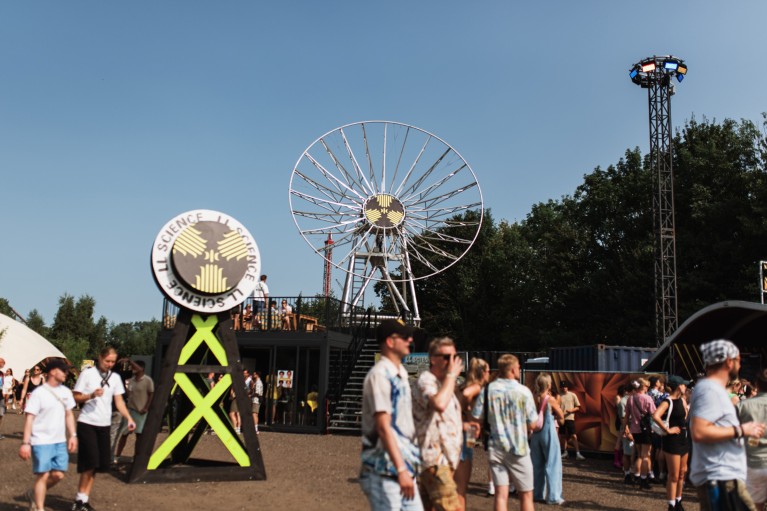
Every year, festival-goers can take part in any of the ten selected projects at Lowlands Science.Credit: Michelle Piergoelam for Nature
Each year, researchers at institutes across the Netherlands submit proposals for projects they would like to do at Lowlands. Pander and her team sift through the projects, selecting the ones they think would work best for the festival. This year saw a record 82 submissions, 10 of which were selected.
In addition to Schrauwen’s study, titled Viva La Vaginoom (Long live the vaginal microbiome), this year’s festival had projects spanning many disciplines and formats. To the left of Schrauwen’s display, a group of researchers at the University of Amsterdam have transformed their shipping container into a Wild West saloon, as part of their project to assess the best way to learn a new skill (in this case, line dancing). Nearby, another group at the University of Amsterdam is shepherding participants into a human-sized glass box to simulate a stressful situation for their study on success and failure. And one shipping container features a “pornfession booth”, for a project that looks at how a person’s socio-economic background affects their perception of sex.
Sounds of science: how music at work can fine-tune your research
Previous projects have been just as innovative and unusual. There has been a clinical trial comparing different methods of resuscitation, an experiment analysing mosquito attraction and a booth where participants were asked to assess their feelings towards their genitals. Last year, one of the most popular experiments was the Shitty Science project, for which participants donated a stool sample as part of a study on gut bacteria.
The data collected have an impact, too. The group studying resuscitation has published five papers in peer-reviewed journals1,2, including one in JAMA Cardiology2 that compared virtual-reality training with in-person guidance (the researchers concluded that virtual instruction was effective in some measures but more research is needed). Another study, which looked at how humans conceptualized high-calorie food, was published in Scientific Reports3. The group working on mosquitoes was able to assess a wide variety of hygiene, eating and drinking behaviours thanks to the festival’s format, leading to a better understanding of what influences the insect to bite.
In addition to the ten research studies a year, Lowlands Science invites groups that focus on scientific communication and education. One of this year’s hits was an interactive recycling game, similar to the game Bop It. Participants had to correctly demonstrate what makes plastic packaging ready to be recycled — by ‘ripping it’, ‘twisting it’, ‘crushing it’ or ‘binning it’.
Why a festival?
Music festivals can be a great place for science experiments for several reasons. Between artist performances, there is a lot of downtime for participating in projects.
“What is great about a festival is that you can combine the fun things of a festival — chatting to friends watching music — but then also be able to learn a new skill,” says physician Joris Nas, who was part of the group at Radboud University Medical Centre in Nijmegen that studied resuscitation methods.
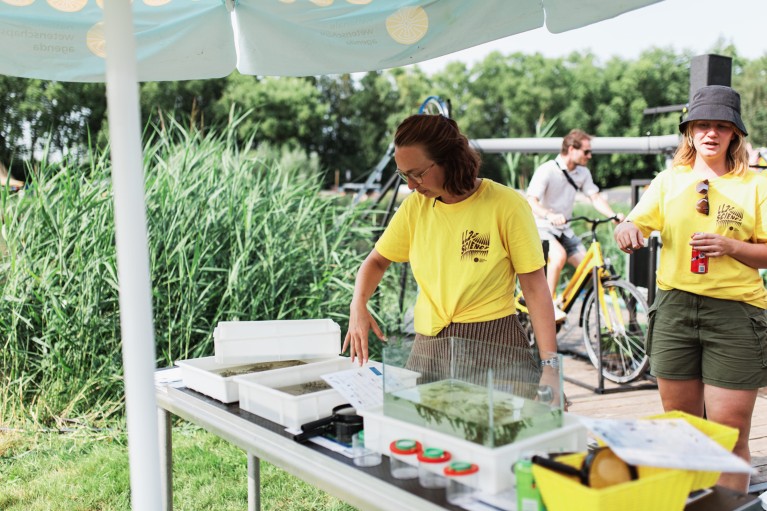
Festival participants take samples from a local lake to learn about biodiversity.Credit: Michelle Piergoelam for Nature
Festivals also help to solve a notable challenge that many researchers face: recruitment. It can be hard to find a large group of people willing to participate in a study, especially individuals who aren’t part of the university ecosystem. But Lowlands’ size — more than 60,000 attendees — helps to mediate this, providing researchers with a large population to draw from.
For Toon Scheurink, a PhD student at University Medical Center Groningen and one of the leaders of the Shitty Science project, that meant getting a lot more poo than he and his colleagues were used to. “In those three days, we were able to collect stool samples from 200 people, which is of course much faster than you usually get with patients in the clinical practice,” he says. Some researchers even had to turn participants away — something that rarely happens in a typical clinical setting.
“We had waiting lines with people who wanted to participate in our study, which is really crazy,” says Nas, because normally researchers have to actively recruit and persuade people.
That said, scientists acknowledge it can be a homogeneous throng. The crowds at Lowlands tend to be Dutch, highly educated, from urban areas and on the young side. But that can sometimes work to researchers’ advantage, especially if it’s a target population for the study.
Tips from neuroscience to keep you focused on hard tasks
For example, Samira van Bohemen, a cultural sociologist at Erasmus University Rotterdam, studies what influences a person’s sexual stereotypes and how arousal happens. “Men are difficult to reach for this type of research”, because it’s women who tend to be more interested in social aspects of sex, she says. “But not here at Lowlands.”
Lowlands’ demographic is also appealing for Martijn Wieling, who studies language variation at the University of Groningen. Speech-recognition software work best for standard Dutch accents, he explains. But by collecting recordings from participants who hail from all parts of the Netherlands, he and his team can train programs to better recognize all sorts of accent.
The environment is also different from typical lab situations. Researchers and participants “have to be OK with sound”, says Pander, because music blares in the background. The festival is also completely outdoors — so, although the shipping containers enable some temperature control, weather can get in the way. This year, the first day was rainy, which some scientists said affected data collection.

Avans University of Applied Sciences in Breda, the Netherlands, organized a ‘field lab’ to raise awareness of vaginal health.Credit: Michelle Piergoelam for Nature
And because the research is done at a music festival, there are some confounding factors: most notably alcohol and drugs. For many projects, participants must answer quick questionnaires about their substance use or have their breath analysed. This can sometimes disqualify them from participating in the study. But researchers can often use this to their advantage, too. One year, a project led by scientists at the University of Amsterdam looked at whether urine could serve as fertilizer, and they wanted to know whether drugs or alcohol would influence fertilizer’s quality. Lowlands was a perfect setting to test this.
Not to mention that for certain types of study on drug use, having participants who are already voluntarily under the influence makes for a good workaround of red tape. A lot of the research at Lowlands tends to be on taboo topics — although this is mostly because it’s a willing and relaxed audience, and organizers pick studies they think people will have fun participating in.
“We get relatively more proposals on taboo subjects”, because Lowlands’ visitors are more open to it than most people, Pander says. “After all, sex, drugs and rock and roll go together quite well.”
Conducting research at Lowlands can also have professional benefits, especially because many of the researchers tend to be at an early stage of their career. Nas says, “50–60% of my thesis was based on Lowlands, so my PhD is actually largely done on Lowlands data.”
Looking forward
When doing research in unusual places, such as a festival, Pander emphasizes the need for applicability. Although people are usually willing to contribute to science, they need to know the impact of their participation. “One major tip is to think about how you frame something, so that people know it’s actually something that matters,” Pander says.
And because there’s a lot going on at the festival, competing for participants’ attention, projects should be short. Once projects are selected, the Lowlands Science team helps the researchers to adapt their study, making sure it requires only 20–30 minutes of the festival-goers’ time.
Format is also key to making the process appealing and inviting — people can get fatigued with research and extensive surveys. For example, the Shitty Science researchers made their project stand out by putting a large golden toilet in front of their shipping container.
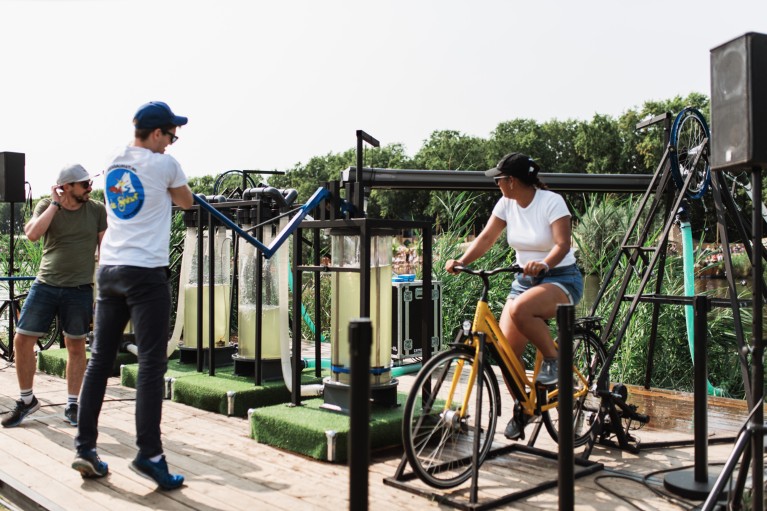
Participants use a bike to pump lakewater through a filter to investigate local biodiversity.Credit: Michelle Piergoelam for Nature
“Look for creative ways that are empirically sound to do but also attractive to a research population,” van Bohemen says. “Get into the shoes of your target audience.”
Tailoring studies to the demographic being studied is also important. Wieling and his team, who work in a mobile lab, attend other festivals during the year. They tweak experiments to fit the population they’re working with.
Researchers also highlighted the importance of being able to communicate the science effectively to participants so that people know what they’re contributing to.
“People really seemed interested to follow our train of thought there,” Scheurink says. “A lot of important science is being done a bit secluded, away in an ivory tower of sorts. I think it’s very important to be able to make your research accessible and understandable to a general public.” When engaging with participants, Scheurink and his colleagues would explain the basis of their research: that the gut and brain are connected and that therefore the bacteria present could influence a person’s temperament.
“Most people found it very funny and were quite intrigued by the fact that we could in fact see the link between the gut and the brain,” he adds. “Most people hadn’t really heard about it.”
And, as Pander notes, people are sceptical about science. “A lot of people think it’s something scary that’s happening in these big labs,” she says. “And I think it’s good that you can show people ‘we actually take our work very seriously’ and that they can see it and contribute to it themselves. I think that helps.”
Back at Viva La Vaginoom’s temporary headquarters, the Sugababes have finished their last song. A festival-goer heads to the underwear-lined shipping container. “I have to get my results,” she tells me. By the end of the weekend, Schrauwen and her colleagues have collected 225 samples, which will help them to understand what contributes to a healthy vagina. In the distance, the crowd thins out, for a break before the Irish rock band Inhaler takes the stage.


